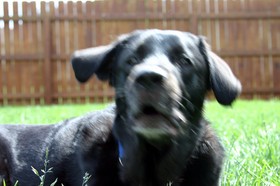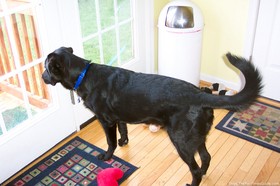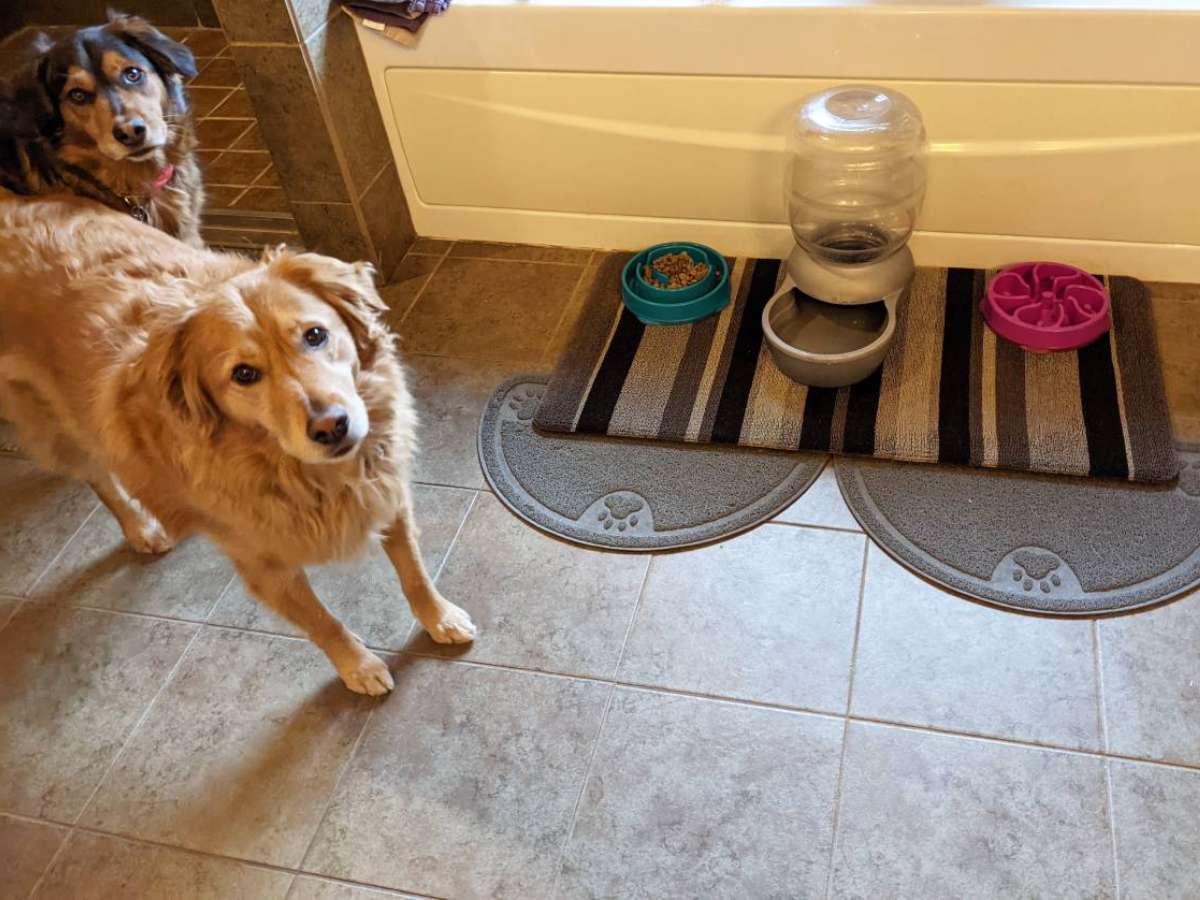Earlier, I wrote about my experiences with dog trainer Suzy Godsey, during 4 weeks of over-the-phone dog training.
I didn’t go into much detail there about how I actually got my dog to stop barking — with Suzy’s help. In that article, I mostly covered why Suzy’s dog training methods worked for us.
I’ve saved the step-by-step details of how we did it for this article.
About Our Dog’s Barking Behavior
 In our case, any time the doorbell would ring, or someone would knock on the door, or a visitor would enter the house, our dog Tenor would go wacko.
In our case, any time the doorbell would ring, or someone would knock on the door, or a visitor would enter the house, our dog Tenor would go wacko.
He would bark loudly while trembling a bit, and as we opened the door, he would run to a corner of the room where he could still see the person, but he wouldn’t stay within close proximity to them.
Over time, Jim and I had learned that if a guest at the door would completely ignore our dog, then he would quiet down right away — as long as we didn’t let them into the house.
But if we invited the person in the house, Tenor would run off to some faraway corner of the room and scope them out from a distance. He wouldn’t bark at them, unless they talked to him. Or, if they brought dogs with them — then, he immediately accepted strangers.
Any time the person walked toward him or tried to pet him (even if he came up to them first), Tenor would simply dash away.
It wasn’t until Tenor was able to come up to the person on his own terms and sniff them whenever he felt ready that he would ultimately feel at ease with whomever was in our house. Usually, this would take 30-40 minutes. As Tenor got to know people better, the time it took him to warm up to them decreased.
He didn’t always do this. It wasn’t until he was about 2-1/2 years of age that he started this type of barking behavior. He’s 3 now.
So, I got in touch with Suzy, and after only one week, we had made significant progress with our dog’s barking and nervous behaviors around strangers. (Which, I have to admit were 100% our fault, because we didn’t socialize him around other people when he was a puppy.)
Here are some of the notes I jotted down during my training sessions with dog trainer Suzy Godsey…
Dog Trainer Meets Dog
After completing a lengthy survey prior to our first phone conversation, Suzy could tell right away that we were dealing with a hyper-sensitive (or rather, overly perceptive!) dog. There is not a thing that goes on around here that Tenor is not 100% aware of.
Therein lies the difficulty. He feels that every noise — like the doorbell, knocking, or a visitor walking into our house — is something that he must alert us to and attempt to remedy.
But really, he just freaks out, not knowing what to do.
The fact of the matter is, we haven’t properly trained him how he should behave in those situations. Suzy said we need to let him know that we are 100% in control during those times, not him. We should try to convey that he doesn’t need to worry about the doorbells, knocks, and guests entering the house. That’s OUR problem, not his.
After he feels confident that we are, in fact, in control during those times, he will stop the barking. Because the barking is a sign that he is trying to control those situations — whether it be to alert us or to protect us. (Our thought is he’s trying to alert us, because he’s an overly submissive dog and doesn’t bite or growl, ever.)
Week 1 Notes: Dog Barks At Doorbell & Strangers
 So, after Suzy learned what we were already doing to try and prevent our dog from barking, she suggested that we (Jim and myself) try to behave differently the next time the doorbell rang, someone knocked, or a visitor came into the house.
So, after Suzy learned what we were already doing to try and prevent our dog from barking, she suggested that we (Jim and myself) try to behave differently the next time the doorbell rang, someone knocked, or a visitor came into the house.
She asked what we do if someone tries to pet our talk to our dog even after we’ve told them that our dog would warm up better to them if they didn’t. I said I pretty much just hope for the best, but I know that he’s not going to like if they approach him first.
Suzy said we have to show Tenor that we are 100% in control of the situation by protecting him from the things that frighten him (guests in our house). So we should instead put our foot down and boldly ask the person not to pet or speak to our dog yet.
That made sense.
She reminded me of the fact that we are always communicating with our dog — even when we’re not meaning to. He picks up on all the non-verbal cues and actions that we make in his presence.
At times when our dog is frightened (or barking), we should try to let him know that WE are in charge… everything’s okay… and he doesn’t have to worry about anything. That alone will be calming and reassuring to him.
The idea is to make the doorbell predictable, and assure him that WE are in control and he’ll be alright.
To do that:
1. Put a leash on your dog and stand a few feet away from the door. Ask someone to ring the doorbell and when the dog starts to run away, tug on the leash. This causes him to re-focus and look at you for direction (if not the first time you do it, then soon, after many tries). Don’t cause more trauma for your dog by not letting him run away if he’s inclined to do so whenever the doorbell rings, so this could take many trials — until he’s comfortable with not running away when you’re in control and he’s on the leash a few feet away from the door. In our case, it only took a few times.
2. Once your dog has that first step down (it could take a couple tries, or a couple weeks; all dogs are different), ask someone to ring the doorbell AND THEN open the door ajar so the dog can see the person. Make sure the person is calm, quiet, doesn’t look at your dog, and doesn’t move at all until you instruct the person it’s okay to do so. At this same time, you’re trying to show your dog that you are 100% in control here. He’s simply on the leash and remaining calm (hopefully; if not, revert back to an earlier step where your dog doesn’t feel threatened).
3. Once your dog is comfortable with someone standing within his view, with the door ajar, ask the person to toss one of his favorite treats to him. The idea is that your dog’s calmness is what gets him a treat. If your dog starts to freak out again, then ask the person to take a step back and if the dog gets calm again, then ask the person to toss another treat. Remember, they shouldn’t look at your dog or talk to him at this point. You’re simply trying to get the do comfortable with the presence of someone else being in your doorway.
Remember to correct your dog’s desire to run away with a single short and quick tug, not a forceful ya
nk. And do not continue this if your dog looks scared or is out of control. This only works from a state of calmness.
The biggest thing I learned in Week 1 with Suzy: We should always acknowledge Tenor’s awareness of things. If he sees something, talk him through it, “You see people outside?… Yes… I see people outside too! I got it… I’m in control here. You don’t need to worry about them. I got it!”
The idea is to connect with your dog 24/7. If he looks at you, talk to him. Talk him through every little thing that’s going on, because that is why he’s looking at you! He is asking for direction… guidance… confirmation that you see what he sees or hear what he hears.
Week 1 focused on communicating on Tenor’s level and letting him know “I GOT IT… It’s okay… You just sit there and mind you’re own business…. It’s okay… I got it… You don’t need to be scared or worry about what to do… I’m 100% in control here… you don’t need to be in control of these situations anymore… I got it.”
Bonus Tip From Suzy: If you aren’t comfortable asking a neighbor or friend to go through this type of training with you for a few minutes one day, then offer a neighborhood kid $5 to do it!
Week 2 Notes: Dog Barks Out The Window
 After trying out Suzy’s suggestions — with the doorbell a couple times and with someone entering the door a couple times, it got easier.
After trying out Suzy’s suggestions — with the doorbell a couple times and with someone entering the door a couple times, it got easier.
The biggest thing that made a difference and actually caused Tenor to stop barking that week was acknowledging the things he was seeing and feeling and saying “I got it!” Not yelling it… but rather in a calm and solid voice stating it as a fact. As if there’s no need for him to worry about it any longer… because “I’ve got it!”
This was huge.
Next, Suzy suggested we ask ourselves, “What will it take for this to change?”
She also mentioned how much it helps to simply be willing to have more tools in your toolbox now for this dog. Those things we tried in the past hadn’t worked, so now it was time to “think outside the box” and try something new. That’s all.
So anytime we sensed the dog was about to bark, we simply asked, “What do you see… ah yes, I see it. I got it!” That alone truly put our dog at ease.
One other behavior that I mentioned to Suzy that works for our dog is putting him in the “sit “position. For some reason (and for which we are thankful), we can tell our dog to sit even when we are far away, and he will drop what he’s doing and immediately sit. This effectively breaks his focus on whatever it was that was getting him uptight or causing him to bark.
So during that first week, any time we thought Tenor was about to bark, we would calmly state, “I got it.” and ask him to sit. (Which is usually just done with a hand signal, but sometimes saying it makes it happen faster.)
Suzy also reminded us to acknowledge Tenor’s good behaviors with “good quiet” any time he didn’t bark when he normally would have in the past. The same is true any time we got him to sit and be quiet while barking. Reassure him with “good quiet” and a treat occasionally too. Praise for good behaviors is a given in dog training.
Oh, and she reminded us of another commonsense thing: never tell your dog what NOT to do, but rather what TO do.
Week 3 Notes: Dog Barks In The Backyard
 I happily reported to Suzy that we were having great success at preventing Tenor from barking at the front door (doorbell, knocking, or guests entering), and we had actually gone so far as to use those same tactics to prevent him from barking out the window whenever strangers or dogs walked by.
I happily reported to Suzy that we were having great success at preventing Tenor from barking at the front door (doorbell, knocking, or guests entering), and we had actually gone so far as to use those same tactics to prevent him from barking out the window whenever strangers or dogs walked by.
Suzy’s tips worked just as well in that scenario. We simply made it clear that we were 100% in control of the situation… we saw what he was seeing… he didn’t need to worry about it… I got it!”
That almost immediately put an end to this type of barking as well.
Oh, and we also gave Tenor treats any time there was absolutely no barking at all at times when he definitely would have barked in the past.
Then I mentioned another similar situation that we were having difficult with: Tenor’s barking in the backyard. We have a 6-foot high privacy fence, and he feels inclined to bark any time someone walks by, or a neighbor is outside grilling, or a dog is running through the nearby field. He only barks whenever we’re not out in the yard with him.
I had tried using the same tips that worked so well in the other situations, but so far, they weren’t working as easily in the backyard. So Suzy suggested a new thing to try…
She said there comes a time when you need to pull out all the stops and talk in a tone that makes it 100% clear to your dog that you’ve had it, you’re not going to take it anymore, there’s no need for this type of behavior to continue any longer, this will be the very last time. Period. You must look and sound differently than you’ve ever sounded before. This time it’s different, and your dog needs to pick up on that.
She reminded me of the fact that your dog picks up on your energy, based on your tone of voice, your body language, and your actions. So this can go a long way, if done properly.
Suzy said to have this heart-to-heart with Tenor at a time that he is barking in the backyard and he won’t stop. The point was to make it clear that he is only to bark whenever a stranger comes physically comes into the yard.
For me, this was the most difficult task to accomplish. One, I didn’t want to be talking firmly and loudly in public in the backyard where neighbors could hear me. And two, I didn’t quite “get” the fact that a dog can understand the “only when a stranger comes into the yard” part.
I did have the heart-to-heart in a semi-meaningful way with Tenor’s full attention, but it was awkward. And while we’ve definitely lessened the amount of barking that Tenor does in the backyard, we haven’t completely stopped it just yet. It is however, much easier to break his concentration and get him to focus on me instead of whatever he was barking at in the backyard. That is a good thing.
Every dog and every situation is different, but Suzy Godsey’s dog training tips have worked wonders in breaking our dog’s obsessive barking habits!




